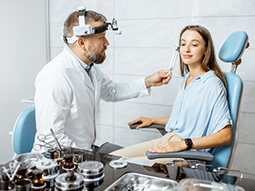
Signs and symptoms of hearing loss
Hearing loss can develop at any age and may be caused by many different factors. A hearing loss is categorized in 3 different ways:
Sensorineural hearing loss occurs when the inner ear or the hearing nerve itself becomes damaged. The most common type of hearing loss, it can be a result of aging, exposure to loud noise, injury, disease, ototoxic drugs, or an inherited condition. Sensorineural hearing loss is typically not medically or surgically treatable. Most people benefit from the use of hearing aids. Conductive hearing loss occurs in the outer or middle ear where sound waves are not able to carry all the way through to the inner ear. Sound may be blocked by earwax or a foreign object in the ear canal, the middle ear may be impacted by fluid and infection, or the eardrum may have been injured. For some people, it may be reversed through medical or surgical intervention. Otherwise, hearing aid use may be recommended.Mixed hearing loss is a combination of sensorineural and conductive hearing loss.
Signs and symptoms of hearing loss vary from person to person but can include:
- Difficulty hearing on the telephone
- Often asking people to repeat themselves
- Difficulty hearing people speaking when there is noise in the background
- Difficulty following a conversation when two or more people talk at once
- Finding that most people seem to mumble or not speak clearly
- Misunderstanding what others say and responding inappropriately
- Difficulty understanding the speech of women and children
- Turning the TV volume up until people complain it is too loud
- Frequently hearing ringing, roaring, or hissing sounds
- Finding that some sounds seem too loud or too soft
If three or more of these apply to you, it is a good idea to have your hearing checked by a MedStar Health audiologist.
Hearing Loss
During normal hearing, sound waves travel through the ear canal and strike the eardrum causing it to vibrate. Age, disease, injury or repeated exposure to loud noise can damage the various structures of the ear and interfere with hearing.
Newborn hearing screening
Hearing aids
Two kinds of technologies are available in current hearing aid models:
Digital hearing aids use a computer chip to process sounds and are the most flexible in adjusting to different listening environments.Analog hearing aids convert sound into electrical signals that are then amplified. These are less flexible than digital hearing aids, but certain hearing impairments benefit from this technology.
Some of the hearing aid systems offered at MedStar Health include:
SoundBite Hearing System: A non-surgical and removable hearing solution for individuals with single sided deafness or conductive hearing loss.FM Systems: A device used to reduce background noise and ensure audibility of a speech signal. It may be used by a hearing-impaired child or a child with normal hearing to help make speech more audible in noisy situations.Cochlear Baha: A surgically implanted, bone-anchored hearing device that may be beneficial for people with conductive/mixed hearing loss or single-sided deafness.Digital Hearing Aids: We dispense and program Oticon, Phonak, and Widex hearing aids in addition to some GNResound, Unitron, Sonic Innovations, and Siemens hearing aids.
Many factors determine which style is most appropriate for you, including the degree of hearing loss, the shape of the outer ear, the size and shape of the ear canal, manual dexterity, space requirements for special features, excessive wax in the ears, and drainage from the ears.
Balance
We regularly care for patients who are experiencing any of the following symptom and conditions:
Vertigo (sensation of feeling dizzy or unsteady in relation to your surroundings) Oscillopsia (jumpy vision)NauseaHeadachesMuscle tensionFatigueMemory or concentration problems Parkinson’s disease or multiple sclerosis Brain injury, post-concussion, or other neurologic conditions
Our specialists treat a wide variety of ear and balance disorders and assess your condition with one or more of the following diagnostic tests:
Electronystagmography records eye movements in order to assess the central nervous system and inner ear function. Auditory brainstem response looks for benign growths on the vestibular nerve and tests for dizziness or unexplained hearing loss. A computer maps how sound travels through the ear canal to the brain in both ears. A difference in travel time indicates a potential problem. Electrocochleography measures how sound signals travel from the ear along the beginning of the acoustic nerve. It also determines if excess fluid in the inner ear is causing a problem, such as dizziness, tinnitus, or hearing loss. It can also confirm endolymphatic hydrops (Ménière’s disease).Pure tone audiometry determines the level of inner-ear function by measuring the faintest tones a person can hear at selected pitches. Sensory organization test identifies balance problems by measuring body sway under different sensory conditions. Oculomotor test measures eye movement as a way to identify potential neurological problems.
Other diagnostic tests that may be performed include:
Functional mobility and reach assessmentStrength and range of motion screeningMotion sensitivity testingRisk for falls assessment
In addition to physical and occupational therapy, a treatment plan for an ear and balance disorder may include gait training, cognitive therapy and patient education.
Location
To find an ear, nose and throat specialist at MedStar Franklin Square, please call 410-248-6300.
MedStar Franklin Square Medical Center 9103 Franklin Square Drive Suite 302 Baltimore, MD 21237
Otolaryngology Specialists
Clarence W. Gehris Jr., MD, FACS
Katherine Day, MD
Carla Lawson, MD
Our providers

Expert audiology care
Getting the care you need starts with one of our audiologists.









